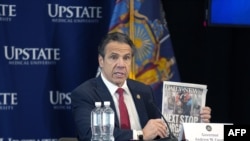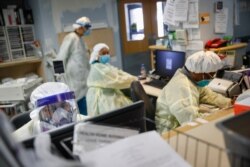As New York state’s coronavirus infection rate continues to decline, the governor announced Tuesday the creation of an advisory board to help bring businesses back online without causing a resurgence in cases.
“Businesses, they have to have social distancing, continued testing, ongoing monitoring protocols — that’s all part of the new normal,” Gov. Andrew Cuomo told reporters at a news conference in the central New York city of Syracuse. “Businesses are going to have to do that if they want to reopen.”
The advisory board consists of more than 100 business, academic and civic leaders.
The state of 19.5 million people has seen nearly 300,000 confirmed cases of COVID-19, the disease caused by the coronavirus. It is the highest infection rate in the United States and surpasses several of the hardest-hit countries, including Spain, Italy and France.
New York state has also suffered a high death toll with 17,638 confirmed COVID-19 fatalities. That number jumps by an additional 5,400 if probable COVID-19 deaths in New York City are included. The city has been the epicenter of the state’s outbreak.
The state is also fighting a skyrocketing unemployment rate because of the pandemic. New York has paid out $3.1 billion in jobless benefits to 1.5 million people since the middle of March and is eager to get as many people back to work as possible.
But Cuomo has been clear that reopening the economy must be done wisely and with caution.
“I am not going to trade off economics for life and death,” he said. “Public health comes first. Life comes first.”
Reopening in phases
The state plans to reopen in staggered phases. All nonessential businesses, as well as schools, are on pause until May 15. At that time, the governor said he will reopen construction and manufacturing activities that are “low risk” but with new safeguards in place.
He would then wait 14 days, the incubation period of the virus, to see if the infection rate spikes. Based on that outcome he would consider a second phase of reopenings, to include more essential, lower-risk businesses. They would all be required to show the state how they would adapt to social distancing and protect staff and customers.
The governor was clear that there is a narrow margin for error in this strategy.
“If the hospital system in an area exceeds 70% capacity,” he said, “or the rate of the transmission of the virus hits 1.1, those are danger signs.”
A 1.1 transmission rate means one infected person is infecting more than one healthy person.
New York has reduced its infection rate to 0.8, meaning the infection is on the decline. But Cuomo said if it spikes above 1.1, New York will quickly find itself back in outbreak territory.
He said regional “control rooms” would be established to monitor local transmission rates for danger signs.
“We have gone through hell and back over the past 60 or so days,” Cuomo said. “We have to respect what we accomplished here,” he said of restrictions and social distancing that have helped control the outbreak.
New York has urban, suburban and agricultural regions. In the less dense and more bucolic northern part of the state — referred to as upstate — the infection rate has been about 7%. In the denser suburbs and cities “downstate,” the virus has found a fertile transmission environment. Cuomo acknowledged this dichotomy.
“Different regions are in a different place. Downstate New York is one of the hardest-hit places on the globe,” he said. “Some of the regions in upstate New York are much like other states … so, we can be at about the same place they are.”
Georgia, Texas, Alaska and Montana are among some of the first U.S. states to loosen restrictions imposed to contain COVID-19.
Testing and tracing
Testing and tracing will also be a vital component to the reopening strategy. New York has been at the national forefront for diagnostic testing for the virus, having performed 845,000 tests so far. It has plans to hire thousands of tracers to notify people who have come in contact with an infected person, so they can isolate and slow the spread.
The state is also expanding and improving antibody testing so New Yorkers can find out if they have been infected with the virus and recovered, as some people have very mild or no symptoms.










